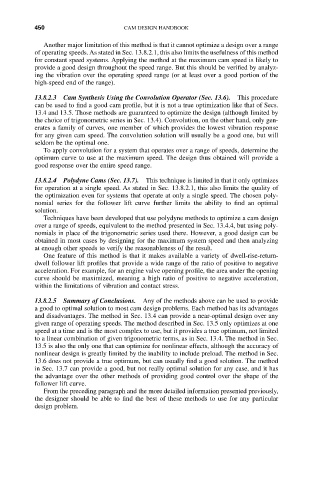Page 462 - Cam Design Handbook
P. 462
THB13 9/19/03 7:56 PM Page 450
450 CAM DESIGN HANDBOOK
Another major limitation of this method is that it cannot optimize a design over a range
of operating speeds. As stated in Sec. 13.8.2.1, this also limits the usefulness of this method
for constant speed systems. Applying the method at the maximum cam speed is likely to
provide a good design throughout the speed range. But this should be verified by analyz-
ing the vibration over the operating speed range (or at least over a good portion of the
high-speed end of the range).
13.8.2.3 Cam Synthesis Using the Convolution Operator (Sec. 13.6). This procedure
can be used to find a good cam profile, but it is not a true optimization like that of Secs.
13.4 and 13.5. Those methods are guaranteed to optimize the design (although limited by
the choice of trigonometric series in Sec. 13.4). Convolution, on the other hand, only gen-
erates a family of curves, one member of which provides the lowest vibration response
for any given cam speed. The convolution solution will usually be a good one, but will
seldom be the optimal one.
To apply convolution for a system that operates over a range of speeds, determine the
optimum curve to use at the maximum speed. The design thus obtained will provide a
good response over the entire speed range.
13.8.2.4 Polydyne Cams (Sec. 13.7). This technique is limited in that it only optimizes
for operation at a single speed. As stated in Sec. 13.8.2.1, this also limits the quality of
the optimization even for systems that operate at only a single speed. The chosen poly-
nomial series for the follower lift curve further limits the ability to find an optimal
solution.
Techniques have been developed that use polydyne methods to optimize a cam design
over a range of speeds, equivalent to the method presented in Sec. 13.4.4, but using poly-
nomials in place of the trigonometric series used there. However, a good design can be
obtained in most cases by designing for the maximum system speed and then analyzing
at enough other speeds to verify the reasonableness of the result.
One feature of this method is that it makes available a variety of dwell-rise-return-
dwell follower lift profiles that provide a wide range of the ratio of positive to negative
acceleration. For example, for an engine valve opening profile, the area under the opening
curve should be maximized, meaning a high ratio of positive to negative acceleration,
within the limitations of vibration and contact stress.
13.8.2.5 Summary of Conclusions. Any of the methods above can be used to provide
a good to optimal solution to most cam design problems. Each method has its advantages
and disadvantages. The method in Sec. 13.4 can provide a near-optimal design over any
given range of operating speeds. The method described in Sec. 13.5 only optimizes at one
speed at a time and is the most complex to use, but it provides a true optimum, not limited
to a linear combination of given trigonometric terms, as in Sec. 13.4. The method in Sec.
13.5 is also the only one that can optimize for nonlinear effects, although the accuracy of
nonlinear design is greatly limited by the inability to include preload. The method in Sec.
13.6 does not provide a true optimum, but can usually find a good solution. The method
in Sec. 13.7 can provide a good, but not really optimal solution for any case, and it has
the advantage over the other methods of providing good control over the shape of the
follower lift curve.
From the preceding paragraph and the more detailed information presented previously,
the designer should be able to find the best of these methods to use for any particular
design problem.

